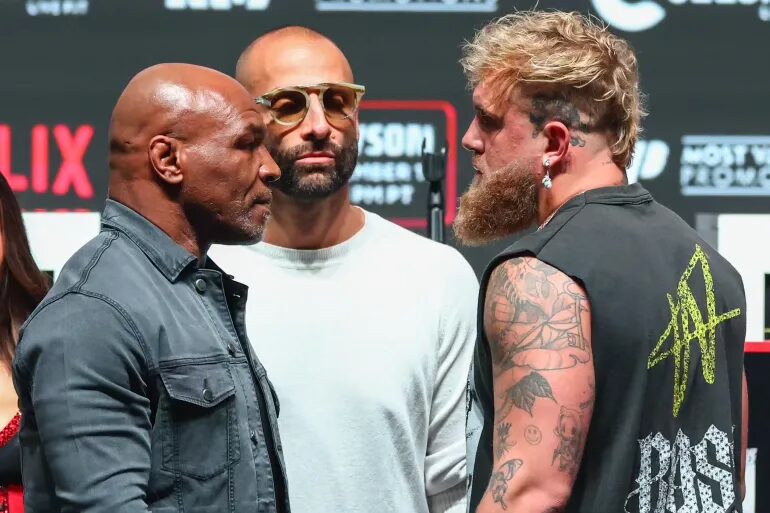Mike Tyson vs. Jake Paul: A Clash of Generations
This Friday, the world of combat sports will witness a unique spectacle as Mike Tyson, one of the most formidable heavyweight champions in boxing history, steps back into the ring for a sanctioned fight against Jake Paul, a social media star turned prizefighter. The bout, set to take place at AT&T Stadium in Arlington, Texas, and broadcast on Netflix, promises to blend nostalgia, entertainment, and sporting curiosity. But with a 31-year age gap and vastly different paths to fame, what does this matchup truly represent?
Tyson: The Legend Reborn
Mike Tyson’s name resonates with boxing fans and pop culture enthusiasts alike. Rising from the harsh streets of Brownsville, Brooklyn, Tyson’s early career was defined by sheer dominance. At 20, he became the youngest heavyweight champion in history, dismantling Trevor Berbick in November 1986. His devastating punching power and relentless pace helped him unify all major title belts by 1988, crafting a 10-0 record with nine knockouts during his reign. His precision and power punches were legendary: Tyson landed an average of 16.3 out of 34.5 punches per round with a 47.2% success rate—far above the division’s average.
Yet, Tyson’s life outside the ring was as tumultuous as his fights. The struggles he faced—incarceration, personal loss, and battles with substance abuse—shaped his complex persona. By the time he faced Kevin McBride in 2005, Tyson was a shadow of the ferocious young fighter fans remembered, losing by TKO in the sixth round. Although he fought Roy Jones Jr. in an exhibition match in 2020, Friday marks his first official bout in nearly two decades. Now 58, Tyson’s comeback is fueled by a mix of curiosity, redemption, and business acumen.
Paul: The Showman-Turned-Fighter
On the other side of the ring is Jake Paul, a figure who defies traditional boxing conventions. Known initially as a YouTube influencer and former Disney Channel actor, Paul made his professional boxing debut in 2020. Though his rise has been met with skepticism, he has proven to be more than just a novelty. His record of 10-1 with seven knockouts is highlighted by victories over former MMA stars and fellow internet celebrities.
While Paul’s fights have been criticized for lacking high-caliber opponents, his dedication to the sport is undeniable. He has trained rigorously and shown growth as a boxer, leveraging his large social media following to promote fights with unprecedented reach. His understanding of promotion and spectacle arguably surpasses that of many traditional boxing figures, making him a formidable force in the modern era of combat sports.
A Battle of Contrasts
The Tyson-Paul showdown is not just an athletic contest but a cultural phenomenon. Tyson, at 58, embodies the grit and raw power of boxing’s golden age, while Paul, 27, represents the media-savvy, entertainment-first approach of modern sport. The fight, set for eight two-minute rounds with 14-ounce gloves—unconventional for heavyweight boxing—tilts expectations. This format, approved by the Texas Commission of Licensing and Regulation, adds intrigue and may favor the younger, more agile Paul.
The fight raises questions beyond the ring. Is this truly a sporting event, or is it a spectacle? Boxing purists may scoff at its legitimacy, pointing out the difference in experience levels and Tyson’s long absence from the sport. Others argue that Tyson’s return to the spotlight highlights his status as a marketing force who transcends the boundaries of age and sport.
A Historical Perspective
Tyson’s participation in media-driven fights isn’t new. In 1998, after being banned for biting Evander Holyfield’s ear, Tyson appeared on WWE’s “Monday Night Raw,” shifting the landscape of sports entertainment. His involvement drew millions of new viewers and changed the fate of WWE, proving that Tyson’s brand could pivot entire industries. Now, as streaming services compete for audience share, Tyson’s pairing with Paul is a strategic move to generate buzz and subscriptions for Netflix.
What’s at Stake?
For Tyson, this fight symbolizes yet another chapter in a storied life marked by extreme highs and lows. Once deemed unlikely to reach his mid-40s, Tyson now steps into the ring as a seasoned survivor who has weathered personal demons and reclaimed his narrative. His transformation into a “tennis dad” with a Goldendoodle reflects his evolution, a testament to resilience and reinvention.
For Paul, the stakes are also significant. Despite his polarizing reputation, he has proven to be a savvy entrepreneur and capable fighter. A win against Tyson, even an older version of the legendary champion, could elevate his status from entertainer to legitimate contender in the boxing world.
Conclusion
The Tyson-Paul bout is emblematic of modern sports culture, where spectacle and legacy intertwine. While it might not be the technical showcase that purists crave, it offers something equally compelling: a collision of eras, personalities, and the forces that drive the sports industry today. As fight night approaches, one question lingers—can Tyson, the original “baddest man on the planet,” still ignite the same spark that captivated millions? Or will Paul, the disruptor, claim victory and continue to reshape what it means to be a modern-day fighter?
Whatever the outcome, the world will be watching, and that’s the essence of a great fight.

